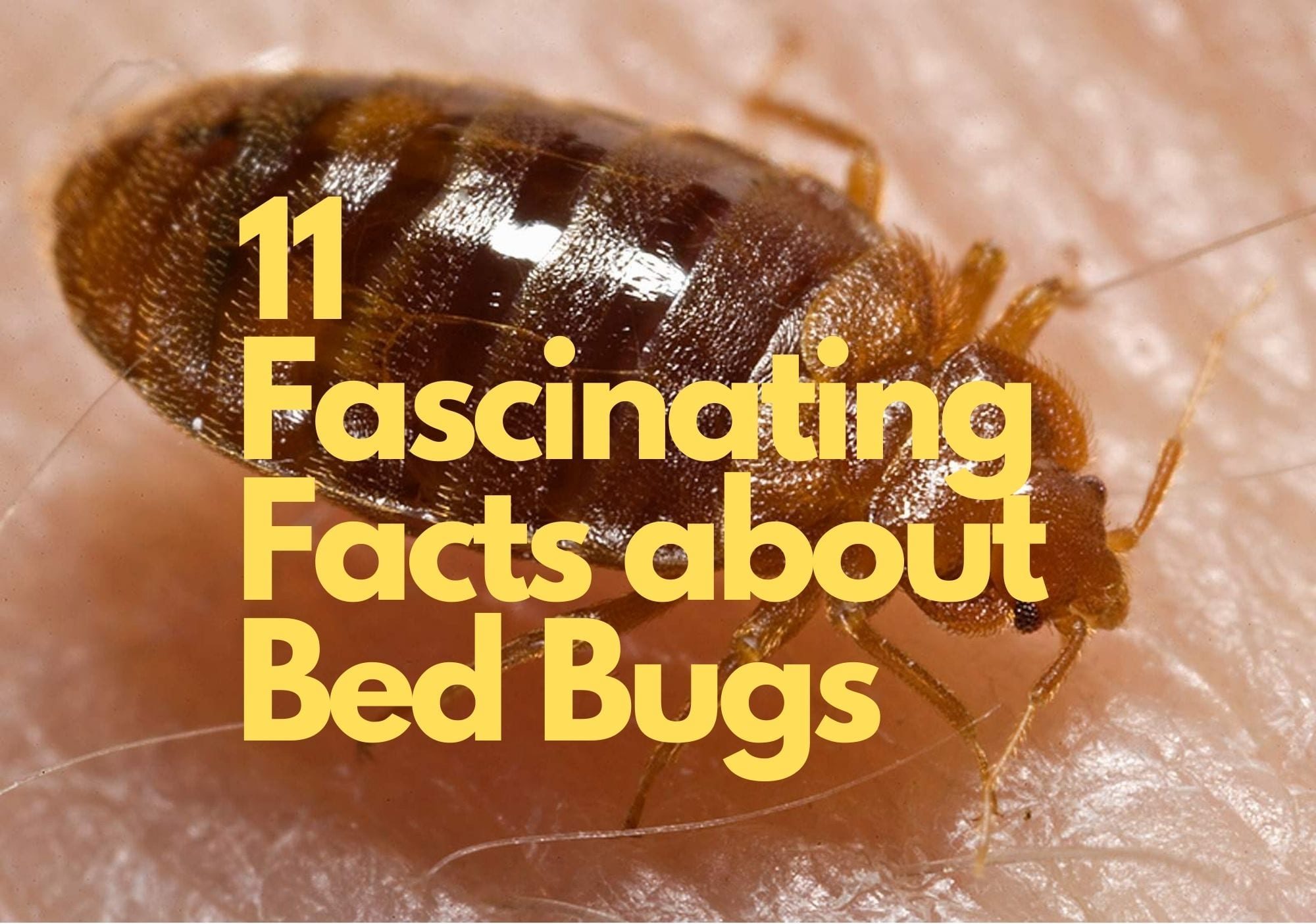

Bed bugs are some of the peskiest pests of all, with their ever-growing populations and itchy bites. They have a reputation as being a simple, yet infuriating pest. In reality, they are a little more complex than they appear, so we put together a list of little-known interesting facts about bed bugs.
1. Bed bugs are everywhere!
Many people associate bed bugs with unclean conditions. A common misconception is that infestations can only occur in places like run-down apartment buildings and motels, or in third-world countries. Unfortunately for us, bed bug infestations can occur virtually anywhere, as long as there are humans around. Bed bugs can be found everywhere on the planet that has been colonized by humans, and they can infest any type of building that we frequent. They are more common in urban areas than rural areas, though, because of larger human population, high-capacity buildings like apartments or office buildings, and increased travel from building to building.
2. Bed bugs can endure extreme conditions
Not very good news to hear, but true nonetheless. Bed bugs can survive temperatures as low as 46 degrees Fahrenheit or as high as 120 degrees Fahrenheit, and eggs can survive temperatures as low as -13 degrees Fahrenheit! The bugs can also survive for roughly 100 days without feeding. What’s more, these persistent pests have started to develop a resistance to the traditional fumigation and pesticide methods used to combat infestations. It’s a good thing Excel technicians know the secrets to bed bug extermination!
3. Bed Bugs can live in more than just beds
It’s true! Despite their name, bed bugs can live almost anywhere that provides shelter, darkness, and desirable temperatures. While mattresses are one such place, bed bugs have also been known to have hiding spots in furniture, luggage, clothing, cracks in the walls, picture frames, and even kitchen appliances! Yes, you read that part right. Because of the heat they give off, appliances like ovens that were recently turned off are quite attractive to bed bugs. Unfortunately for the bugs, they may not make it out before the appliance is used again!
4. Bed bugs are food snobs
That’s right! Bed bugs are actually remarkably picky eaters. They will only feed on fresh blood from a live host. They will turn up their nose at spilled blood or blood stains.
5. Bed bugs can drink a LOT of blood
When we say a lot, we mean a lot. These pests can consume enough blood to equal up to seven times their own body weight. To put this into perspective, that would be the same as an average adult male consuming 120 gallons of liquid all at once!
6. Bed bugs numb their hosts
If you’ve ever experienced a bed bug infestation, you may have wondered, “how did all those little bugs not wake me up when they bit me?” Well, there’s a scientific answer for that. Bed bug saliva has anesthetic and anticoagulant components. These components increase the blood flow at the site of the bite, causing the bite itself to be almost completely painless. Many people don’t feel anything at all when they get bit.
7. Bed bugs have keen instincts
Bed bugs are certainly not the most intelligent insects in the animal kingdom, but with their sharp instincts, they don’t need smarts. They are elusive by nature and know to stay out of view when their hosts are awake. They hide in all sorts of cracks and crevices, resisting their urge to feed until it is safe to come out. Due to the fact that humans exhale carbon dioxide, the level of CO2 in a room rises the longer the room is occupied, especially if the windows and doors are closed. This means that carbon dioxide levels will rise steadily in a room where someone is sleeping. Unfortunately, heightened levels of CO2 is exactly what lets bed bugs know it is safe to come out. Because most people sleep during the night, and bed bugs come out when their hosts are asleep, bed bugs have the reputation of being nocturnal insects. In reality, bed bugs will come out whenever it is safe for them to do so.
8. If you see one bed bug, there are more.
While it is technically possible to have one single bed bug, it is highly unlikely due to how quickly they reproduce. Female bed bugs are able to lay up to five eggs a day. Given that a bed bug will live for around 300 days in favorable conditions, this means that a single female can lay between 200 and 500 eggs in her lifetime!
9. Bed bugs are slow
Bed bugs tend to do most of their traveling on a host or a host’s possessions, like clothing or luggage. This is because bed bugs are relatively slow movers thanks to their tiny size. They are so slow that they can only make it 3 or 4 feet in a minute. A bed bug would take almost an entire day just to move a mile!
10. Bed bugs can’t climb smooth surfaces
Bed bugs are not the strongest climbers in the first place, but when it comes to smooth surfaces, they cannot climb at all. They need something to grip onto which smooth, clean surfaces do not provide. Now, the question is, what counts as a smooth surface? Can bed bugs climb walls? Most walls, yes. Painted or wooden walls usually have enough texture to grip onto. Glass or tile walls, on the other hand, are an impossible obstacle for bed bugs because they are perfectly smooth. As luck would have it, you can actually use their inability to climb smooth surfaces to your advantage. If you’re bringing a new piece of furniture or luggage into your home and are unsure if it contains bed bugs, just place it in a clean, empty tub until you are able to inspect and wash it. Bed bugs can’t jump or fly, so they will be trapped in the tub if they decide to leave the furniture or luggage.
11. Bed bugs can contract human pathogens
That may sound like bad news for us, but it is really only bad for the bugs. While they can be infected with human pathogens, no studies have ever shown that they are able to transfer any pathogens back to us.
More fun facts about bed bugs
How far can bed bugs travel?
Bed bugs prefer to stay close to their food source and seldom wander far. Studies show they will regularly travel up to about 20 feet from their harborages to feed before returning to a hiding placecleggs.com. When crawling, they are quite slow, about 3 to 4 feet per minute, meaning it would take them an entire day to travel a mile. However, bed bugs spread efficiently by hitchhiking on clothing, luggage or furniture. Pest control experts note that a single bed bug can move 100 feet or more in an hour if it crawls continuously, and they can spread quickly from one room to the next by riding on people or belongings. Their ability to survive for months without feeding allows them to remain hidden and wait for a new hostcleggs.com.
Can bed bugs fly or jump?
Unlike fleas or other insects, bed bugs do not have wings and cannot fly or jump. Orkin explains that they are wingless, blood‑feeding insects that undergo gradual metamorphosis and move only by crawling. They use their six legs to scuttle across floors, walls and ceilings, but they cannot leap onto hosts. Instead, they travel from host to host by hitching rides on belongings, clothing or bedding. If you find bed bugs in an upper story or isolated area, it’s because they have been carried there, not because they flew or jumped.
Where do bed bugs like to hide?
Bed bugs are nocturnal and hide in dark, secluded areas during the day. Orkin notes that infestations often originate in mattresses, box springs, bed frames and couch cushions. As populations grow, they spread into nearby hiding places such as clothing, linens, under clutter, wall voids and around window and door moldings. They squeeze into cracks in wood trim and dresser drawers and are even found in taxi, bus and airplane seats by crawling into upholstery. Bed bugs will hide almost anywhere they can remain undisturbed: inside picture frames, behind electrical plates or under loose wallpaper. Because they are so flat, they can slip into crevices as thin as a credit card. Thorough inspection of these areas is crucial when investigating an infestation.
Does vacuuming kill bed bugs?
Vacuuming is a valuable part of bed bug control, but it does not kill them outright. The North Dakota State University extension says that vacuuming is an effective way to remove bed bugs, especially from seams and edges of mattresses, box springs and along baseboards. After vacuuming, immediately dispose of the vacuum bag in a sealed plastic bag outside the home to prevent escapes. Vacuuming may not remove all eggs and will not kill hidden bugs; it merely reduces numbers. The publication cautions against vacuuming immediately after applying insecticide because it may remove the residue needed for long‑term control. To eliminate bed bugs completely, integrate vacuuming with other control measures such as heat treatment, steam cleaning and professionally applied insecticides.
Do bed bugs go into your hair?
Despite the fear factor, bed bugs rarely live in hair. Healthline explains that these insects prefer to hide in crevices near sleeping areas, coming out to feed and returning to a hiding place. They dislike heat and are not designed to cling to hair like lice or fleas, so they don’t stay on scalps. A pest control blog notes that bed bugs are heat‑sensitive and not built to crawl through hair, and they leave the host within minutes after feeding. If one happens to crawl onto your head, it will quickly retreat; regular bathing will wash it away. Seeing a bed bug near your hair usually indicates a nearby hiding spot rather than an infestation of your scalp.
Although these facts themselves don’t make bed bugs any less bothersome, you are now armed with knowledge that could help you avoid or manage infestations in the future. If these facts aren’t enough though, and you find yourself in the midst of a bed bug infestation, give Excel a call and we’ll send our experts your way.
For more information regarding bed bug pest control take a look at our resource page.






